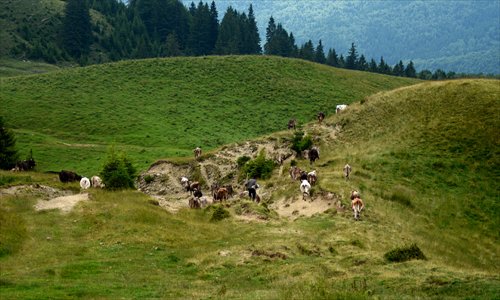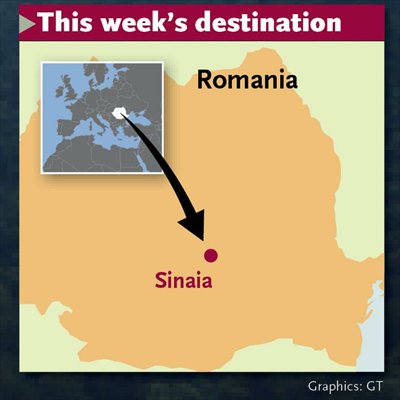Roaming Romania
A Carpathian adventure between modernity and tradition

A view of the city of Brasov Photo: Angela Corrias

Dambovita river in Bucharest Photo: Angela Corrias

View of the grasslands of the Sinaia-Bucegi mountains Photo: Angela Corrias

This week's destination
I've always known Romania offered beautiful natural scenery, but when seemingly limitless fields of sunflowers unfolded before my eyes during my train journey from Bucharest to Sinaia, a quaint little town nestled in the Prahova Valley, I couldn't help but stare in awe out of my window seat.
Located some 800 meters above sea level against the spectacular backdrop of the Carpathian mountains, Sinaia is one of Romania's most popular winter resorts thanks to the perpetually snow-covered peaks of the nearby Bucegi Mountains and the many activities available during the cold season, from snowboarding to extreme skiing. Framed by poplar-clothed hillsides and blessed with lush vegetation all year round, it's not without reason that Sinaia bears the moniker of "Pearl of the Carpathians."
Simply taking a walk around the town reveals much of its identity, strikingly well preserved due to being perpetually on the outskirts of the main roads and hardly an easy reach. Little to no traffic, surrounding slopes festooned with red-roofed houses built in traditional styles and a heady smell of freshly baked bread throughout the day are the main features of this town that at first sight looks like a sleepy hamlet in the middle of nowhere, but after a closer look reveals a fascinating history.
It was the year 1690 when Wallachian prince Mihail Cantacuzino, back from an apparently life-changing pilgrimage to Saint Catherine monastery on Egypt's Mount Sinai, commissioned the construction of the Sinaia monastery. This is also how the town sprawling around the monastery, got its name. With the double purpose of defending a local commercial route and sheltering the needy, the old monastery was built in a new Brâncovenesc architectural style. Cross-shaped, its thick stone and brick walls are embellished with precious paintings and frescoes, with a small porch welcoming worshipers from a pint-sized entrance framed by images of heaven and hell.
When the ancient monastery became too small to house the increasing number of monks, a second, bigger church and attached cloister, were built between 1843 and 1846. They are all finely decorated with inlaid wooden carvings and beautiful paintings representing Romanian queen Elizabeth with her daughter Mary, who died still a child, and the founder of the first complex, Mihail Cantacuzino.
I reached the monastery after walking up a quiet tree-lined road at the end of which bulky hay bales conveyed an image of rural traditions that are still very much alive and well. Not far from here, following another tree-lined boulevard, the eerie, yet intriguing view of the Peles Castle unfolded before my eyes. Luxurious summer retreat of King Carol I, the castle is an architectural jewel of German new Renaissance. Its interior is decorated with artwork from different countries, each room and each space reproducing a different nationality as a way for the king to vicariously relive his travels through the objects he brought from around the world to the castle.
Land of Dracula
From the valley created by the Prahova River, in the southern part of the Carpathian chain, I carried on with my journey towards the northern slopes of the Transylvanian Alps to stop in Brasov, a charming town located at some 170 km from Bucharest. Known by horror movies fans for being the departing point to the infamous Bran Castle, also known as Dracula's Castle and the region's top tourist attraction, Brasov was founded by the Teutonic Knights in 1211 in the strategic position on the border between the three historical regions of Transylvania, Wallachia and Moldavia, and was influenced by the strong presence of the Saxons throughout the centuries who, apart from building several fortresses, made it a commercial hub for trading weapons and clothing goods.
Even though one of Romania's largest cities, Brasov exudes a village-like atmosphere as quiet as it is welcoming, probably due to its secluded position, ringed by forest-covered mountains on three sides, or to its medieval legacy that still shows with its fortified walls and turreted citadel erected in a time when foreign invasions were a daily practice.
From my hotel, I could detect the imposing roof of the Black Church, Romania's largest Gothic church, that earned its name after a fire in 1689 darkened its walls with black and smoky shades. Its construction began in the fourteenth century, and after an existence led between fires and destroying invasions, today the church dominates the skyline both from the main square Piata Sfatului and from the elevated viewpoints of the outer fortress and Mount Tampa, the peak of which can be reached via an easy hiking trail or a few minutes of cable car.
What I deemed as the best way to take in the old town was to get lost in the maze of its winding cobbled alleys, and I was right. Starting from the very central Piata Sfatului, a tangle of narrow streets slowly unfolded revealing a hidden gem at every bend and a piece of history at every corner, from medieval Catherine's Gate to the White Tower.
This is a place filled with whimsical folktales where the line between myth and reality has always been fuzzy, as it's the case of the notorious Vlad Dracula, whose habit of dealing with enemies by skewering them earned him the unflattering moniker of Tepes, The Impaler, and who inspired Bram Stoker's famous vampire novel.
Literally "the land beyond the forest," Transylvania is a fascinating region that should be explored slowly in order to gradually unearth its medieval legacy and seductive natural heritage.
After a quick 20-minute bus ride, a feast of vampire-themed t-shirts and fridge magnets made it clear that we had just reached Bran Castle. Fans of both Stoker's novel and all the movies and TV shows that followed might feel disappointed that while the notoriously popular count did exist, Bran's castle not only was never his, but it's even in doubt whether he ever stepped over its threshold.
Nevertheless, a visit to the old mansion made for an interesting glimpse of yet another piece of the region's stormy past, from its erection by the Saxons of Brasov to more modern times when it became a royal residence.
To the capital
Following the Carpathian trail up to its sudden end north of Bucharest, and after a three-hour train ride southward, I wound up in the country's capital and main city of the historical region of Wallachia.
In the 1920s Bucharest was known as "little Paris," and with a suggestive stroll in its old town crammed with Belle Époque bars and outdoor tables, I understood why. Exuding an aristocratic ambiance, the neighborhood sprawling around Lipscani Street is overcrowded with classic-style historical buildings, Orthodox basilicas (Biserica) and semi-hidden passageways emerging into tree-lined boulevards and delectable bakeries.
Bucharest, in fact, is most famous for two things, its museums, numbering almost 40 and greatly organized, and its natural oases. Among the latter are the picturesque Cismigiu Gardens, just off Calea Victoriei, where I could stare for hours at the bridges and trees reflecting on the waters of its river, and spectacular Herastrau Park, a huge green sweep that in the evening becomes a bustling meeting point for residents who like to round off a working day with a bike ride or dinner on the shores of the lake.
Right here, in Herastrau Park, just when I thought I had left ancestral Romania in the Carpathians, I stumbled on the charming Museum of Romanian Village, a striking collection of some fifty buildings that take visitors on a journey across the country through its most traditional architecture, presenting century-old households, watermills and wooden churches as the soul of a nation that is proudly clinging onto its heritage.
As for me, this last slice of authenticity in the middle of state-of-the-art Bucharest, was the perfect ending of a trip that started with the alluring sights of shingled rooftops and dramatic mountain peaks.
Rules of thumb
Practical information: Despite being popular tourist areas, both Sinaia and Brasov are not very pricey, while the country's capital, Bucharest, is more expensive, especially in central and tourist districts, where a small bottle of water can be charged between 7 and 12 RON ($2-4).
What to say: In Romania English is widely spoken in the most touristy areas, and it's quite common to find also taxi drivers, shopkeepers and passers-by confident in providing information and directions in English. Restaurants' menus are always in both Romanian and English.
What to wear: While Bucharest in summer can be pretty hot, in mountain areas such as Sinaia and Brasov the breeze makes the seasonal heat less blazing. In winter it snows very often and it's recommended to pack clothes and comfortable footwear appropriate for both mountain treks and severe weather conditions.
Where to stay: Both Sinaia and Brasov have a wide range of accommodations. In Sinaia I stayed at 3-star Hotel Bucegi for about $60 per night for a double bed room, while in Brasov I booked a double bed room at the Casa Wagner at about $90 a night.